| History
from a Bicycle Seat |
|
We were eager to learn more about
the history and politics of Cuba. We were thinking mainly of
the revolution of the 1950's and its aftermath, but we found
that the heroes and events of Cuba's independence struggle against
Spain are still prominent in people's consciousness. This is
the old Spanish castle that guards the entrance to Santiago
bay. For one who is interested in Cuban history, Santiago de
Cuba is a great place to start.
|
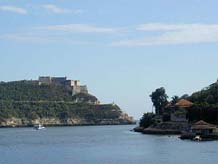
|

|
Here is the site of a battle that
took place just outside Santiago -- in what Americans arrogantly
call the Spanish-American War. In fact, Teddy Roosevelt and
his troops dropped in at the last minute, after Cubans had fought
Spain for decades and very nearly won. Cubans rightfully think
of the conflict as their War of Independence. Still, they honor
Roosevelt as a hero, and we saw statues of him and of Abraham
Lincoln as well.
|
|
We were most interested in the
1959 revolution and subsequent developments. This is the old
Moncada Garrison in Santiago de Cuba. Now a school, it was once
Batista's strongest fortress in eastern Cuba, and it was here
that Castro and over 100 comrades made the opening strike in
their revolution. Over half the attackers were killed outright
or captured and tortured to death. Many of the rest were imprisoned
-- including Fidel and his brother Raul. This event was on July
26, 1953.
|
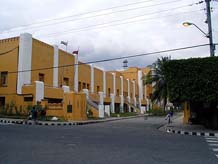
|
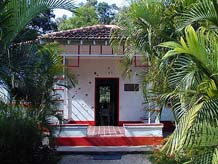
|
This farmhouse near Santiago de
Cuba is where the young rebels assembled before the pre-dawn
attack. It is now a museum, and something of a shrine. Displayed
on the walls are comments by Castro and other participants as
they waited through the night to strike out for the city. Whatever
you may think of Castro and his government, when you read the
words that he and the others spoke that night, you can't help
but be impressed by their idealism and their courage.
|
|
The date of the attack on the
Moncada barracks, the 26th of July, became the name of Castro's
movement and an important revolutionary symbol. You still see
it everywhere.
|

|
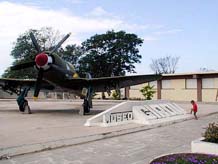
|
As we traveled west, we saw more
history. Remember that Playa Giron is where CIA-backed Cuban
exiles attempted an invasion in 1960. They were defeated, and
over 1000 members of the exile brigade were captured. This is
the museum on the site.
|
|
This sign appears just outside
the village. It says "Playa Giron, the first great defeat of
imperialism in Latin America." The road north from Playa Giron
is lined with small monuments, one for each of the 161 Cubans
who died in the battle. Most of them were practically kids --
20 or younger.
|

|
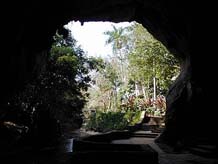
|
Around the time of the Bay of
Pigs, the Cuban government suspected that an invasion was imminent,
but they didn't know where it would come. They took Che Guevara
away from his job as minister of industry to command the western
army. This cave was where Che's army command post was established,
deep in the mountains of Pinar del Rio. Che missed out on the
action, which took place hundreds of miles to the east.
|
|
Soon Che was back in the same
cave to lead the western army during the Cuban missile crisis.
Barb is standing at the desk where he wrote the daily entries
in his diaries.
|
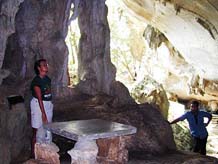
|
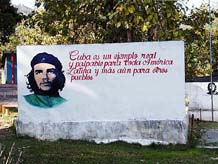
|
Billboards featuring Che appear
all over the country. This one quotes him saying, "Cuba, a real,
tangible example for Latin America, and for other people as
well." Though there are many memorials to Che and a few other
heroes of the 1950's revolution, we saw no billboards or street
names celebrating Castro or other current leaders.
|
|
Apart from many photos of Fidel
with the Pope, this was the only likeness of Castro that we
ever saw in public, and it is kind of a joke. It's in a village
named Fidel Claro, at the entrance to a plantation. The little
figure of the cane cutter is wearing Fidel's trademark beard.
|
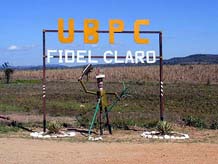
|

|





